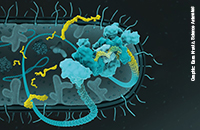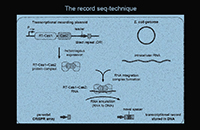

Hijacking the CRISPR System to Create “Living Diagnostics”
Eppendorf Award Winner Randall Platt describes the molecular recorder
September 2020. Randall Platt, Eppendorf Award winner 2020 talks in a Nature podcast about his work on creating a molecular recorder which earned him this year’s prize. Randall Platt is Assistant Professor in both the Department of Biosystems Science and Engineering at ETH Zurich, and the Department of Chemistry at the University of Basel. Below are edited extracts from the interview with science writer Geoff Marsh. Further answers as to how the method is working, or clinical as well as other molecular applications are accessible in the full transcript.
Geoff Marsh: What is a molecular recorder? Randall Platt: A molecular recorder is an emerging class of molecular technology. It’s basically a collection of genes that, when put inside cells, endows them with a synthetic form of memory. A molecular recorder could, for example, take a biological signal — a chemical, a molecule or a transcription factor — and transduce that into changes in a DNA storage medium. Then, through sequencing, we can reconstruct that cellular memory and identify what the biological signal was.
Randall Platt: A molecular recorder is an emerging class of molecular technology. It’s basically a collection of genes that, when put inside cells, endows them with a synthetic form of memory. A molecular recorder could, for example, take a biological signal — a chemical, a molecule or a transcription factor — and transduce that into changes in a DNA storage medium. Then, through sequencing, we can reconstruct that cellular memory and identify what the biological signal was.
What is its relationship to the CRISPR system?
Most people are familiar with CRISPR as gene editing technology, which relies on an enzyme called Cas9. The enzyme acts as molecular scissors to correct a genetic mutation and cure a disease, for instance. But CRISPR is a whole toolbox of proteins.In nature, CRISPR serves as an adaptive immune system for microbes. In humans, the adaptive immune system remembers the pathogens it has encountered and provides resistance against future infections. In a bacterial cell, when it’s infected with a virus, the CRISPR system responds using its army of proteins.
Some CRISPR proteins take a piece of the virus and insert it in the host genome, where it serves as a molecular memory of that invader; at a later point in time, the CRISPR system can recall that memory in the form of a small piece of RNA. This so-called ‘guide RNA’ directs CRISPR-associated enzymes back to destroy viral invaders by cutting them using Cas9, and thus provides the bacterium with immunity.
Our advance specifically focuses on that first step of the CRISPR system: the recording part, where a piece of the virus’s genome is inserted into the bacteria’s. We’re leveraging that recording process to endow other cells with the ability to record RNA, which is a technique we call Record-seq.
How does Record-seq work?
In bacterial cells, the CRISPR proteins form a big multi-protein complex. They grab RNAs, proportional to their abundance, and take a little snippet of them — about 40 nucleotides — that they integrate in a CRISPR array. The array is simply a DNA sequence of repetitive records that are formed iteratively and sequentially. After multiple recordings, it’s like a fossil record. The records are aligned topologically. So we’re not only able to record whether a gene was expressed, but also when it was expressed.
Source: Eppendorf AG; Nature
Disclaimer: You agree that B2Bioworld is not responsible and will not be held liable for any third party content on its sites or any third-party content, products or services available on other web sites accessed through links from B2Bioworld sites. Links to third-party sites are for your convenience only, and their inclusion on B2Bioworld\'s sites does not imply any endorsement, guarantee, warranty or representation by B2Bioworld.
B2Bioworld Comment
 September 2020. The latest inventions of Eppendorf Award Winner 2020, Randall J Platt and his co-workers describe a vector system and methods for recording changes in expression patterns of RNA. CRISPR stands for "Clustered Regularly Interspaced Short Palindromic Repeats. It contains spacers from RNA which are isolated, manipulated and then inserted into a CRISPR array by a Cas1-Cas2 complex (Cong et al 2020; Platt/Schmidt 2020; Zhang et al. 2020). The IP is owned by Swiss ETH Zürich, and four U.S. universities (Broad Institute, MIT, Rockefeller University, and Harvard). eds.
September 2020. The latest inventions of Eppendorf Award Winner 2020, Randall J Platt and his co-workers describe a vector system and methods for recording changes in expression patterns of RNA. CRISPR stands for "Clustered Regularly Interspaced Short Palindromic Repeats. It contains spacers from RNA which are isolated, manipulated and then inserted into a CRISPR array by a Cas1-Cas2 complex (Cong et al 2020; Platt/Schmidt 2020; Zhang et al. 2020). The IP is owned by Swiss ETH Zürich, and four U.S. universities (Broad Institute, MIT, Rockefeller University, and Harvard). eds.
References
Cong L, Cox DBT, Heidenreich M, Platt RJ, Swiech L, Zhang F (2020): Delivery, use and therapeutic applications of the CRISPR-Cas Systems and compositions for genome editing. ES2765481: Oficina Española de Patentes y Marcas.
Platt RJ, Schmidt F (2020): Transcriptional recording by CRISPR spacer Acquisition from RNA. March 19, WO2020/053299: WIPO.
Zhang F, Bikard D O, Cong L, Cox DBT, Hsu P, Jiang W, Lin S, Marraffini L, Platt RJ, RAN F, Sanjana NE (2020): CRISPR-CAS component systems, methods and compositions for sequence manipulation. April 10. CN 110982844A: National Intellectual Property Administration of the People's Republic of China.
Other articles recommended
B2Bioworld offers you background information
Listeria Research Today and Tomorrow
Pascale Cossart, Professor at Institut Pasteur, Paris and Head of Unité des Interactions Bactéries-Cellules
Review: Minute, Tough, and Copious
Science can be fun to read, but be aware. Book Review - open access
Insider Tip – Autophagy Research
- open access
Patenting and Innovation in Japan
Prof Sadao Nagaoka, Institute of Innovation Research, and Chief Policy Adviser to the Japanese Government
Easier Access to Patent Claims Encoded in Chinese
Uncertainty about Rospatent